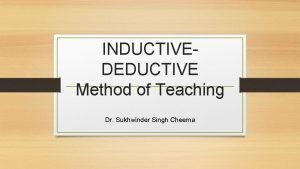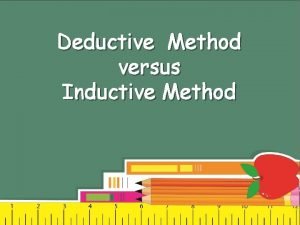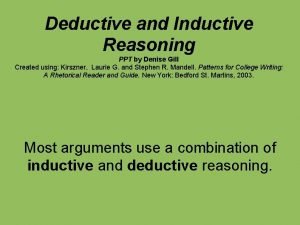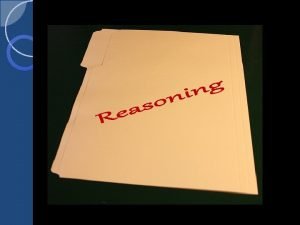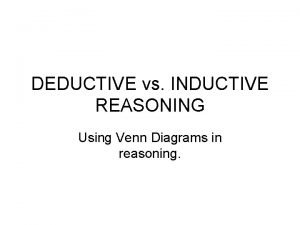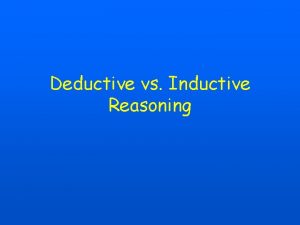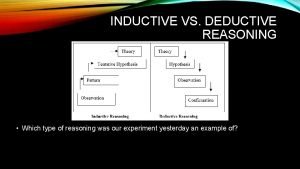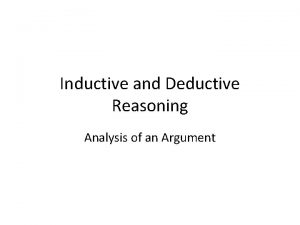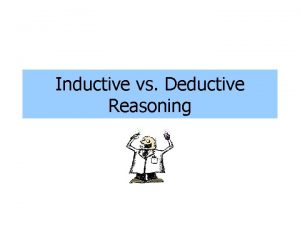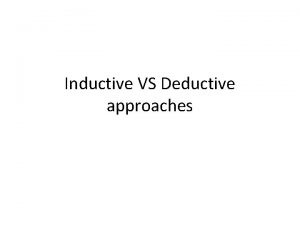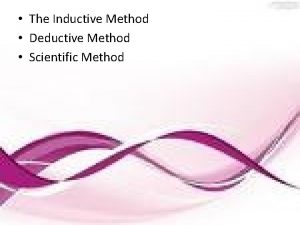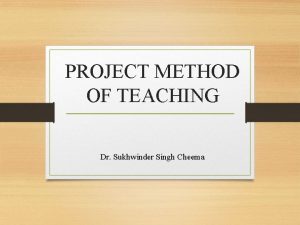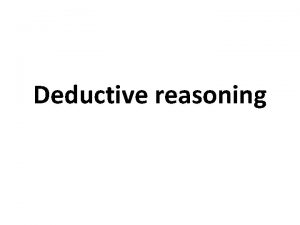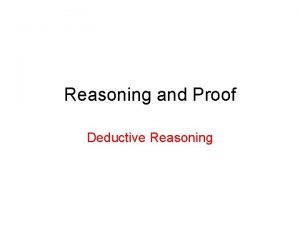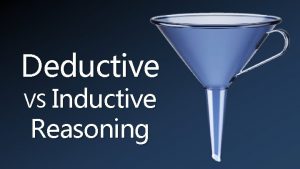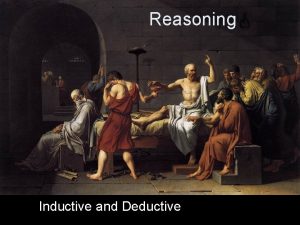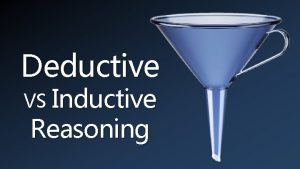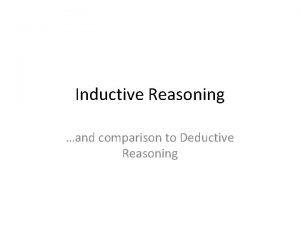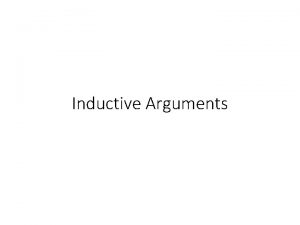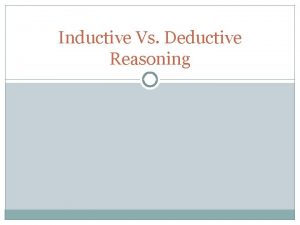INDUCTIVE DEDUCTIVE Method of Teaching Dr Sukhwinder Singh



























- Slides: 27

INDUCTIVE- DEDUCTIVE Method of Teaching Dr. Sukhwinder Singh Cheema

Introduction Induction starts with known instances and arrives at generalizations; This method is generally known as Statistical Method, Scientific Methods and Empirical Method It quite popular method for framing generalisation. In this method we proceed from Known/ Concrete to Unknown/ Abstract

Inductive Reasoning

Etymological Meaning of Induction • Induction (n. ) is from old French word “inductionem” which mean “advancement toward the grace of God; " • Latin word “induction” from the verb inducere which mean "a leading in, introduction, admission, " • Or Greek word “epagoge” which "leading to“ •

Definitions • Keynes, “ Inductive method is to establish laws on the basis of examples or instance. ” • Miller, “Induction is a process of reaching general conclusions from particular instances. ” • William Gee, “Inductive method is a process of reasoning from particular to general or from individual to Universal. ”

Types of Induction Method Experimental Statistical Inductive Method

Experimental Inductive Method • In this method Principles, theories and laws are tested by its application to real life situation or through their real life application in natural settings Statistical Inductive Method • In this method Principles, theories and laws are formulated on the basis of statistical analysis.

Steps of Inductive Method • 1. Collection of evidences/ data: by observation survey and Inspections 2. Formulation of hypothesis: Student with the help of teacher form hypothesis or tentative solutions of the problem

Steps of Inductive Method 3. Discrimination and analysis: Discriminate the factors on the basis of Similarities and Differences in variables and factors And do analysis of the situation 4. Generalisation and Abstraction: On the basis of similarities of trends of a particular Phenomena student reach on generalisation about some principles, theories and Laws

Steps of Inductive Method • 5. Verification: • Students do effort to verify the truth of the principles, laws and theories in the similar situation at different time. • 6. Application/ Prediction: • Verified principle then recommended to apply in real life situation • Or prediction are made about the phenomena

ROLE OF THE TEACHER 1. A guide, friend and philosopher 2. Helps the students in developing tools of data collection 3. Assist students to Generate Resources(Financial and Material). 4. Help to formulate Hypothesis: Assist the students to formulate hypothesis which are feasible and viable as per resources and time limitations. 5. To organize data: During execution of the project teacher should help the students to organize raw data in meaningful way. .

ROLE OF THE TEACHER 6. To allocate the duties 7. Supervise the progress of project work 8. Encourages his students to work collectively, and cooperatively. 9. Help his students to avoid and correct mistakes. 10. He makes it a point that each member of the group should contributed something to the completion of the project. 11. Help to draw inferences 12. Evaluation: Evaluation of the Project work and Reports submitted by the Group.

ROLE OF THE TEACHER 13. Maintenance of Record for timely review and Future Consultation: 14. Teacher should assess the Strength and weakness of the Project task: 15. Feed back and appraisal: 16. Concluding remarks and Submissions:

ADVANTAGES �Psychological laws of learning: It is a method of teaching based on psychological laws of learning. �Students centered: It is students centered and provide scope to entertain Individual Differences( Interest, Capacity and Aptitude). �Active Participation: in this method students Take active Participation �Develop spirit of cooperation/ Cooperative Venture: It imbibes the spirit of cooperation as it is a cooperative venture.

ADVANTAGES �Stimulates interest: Stimulates interest in natural as also man made situations. �Arouse interest: A project can be used to arouse interest in a particular topics as it blends school life with outside world. � Develops Curiosity: By keeping students busy it helps to arouse Curiosity. �Natural Method for Innovative Discoveries: �Permanent Learning: Self-acquired permanent learning

ADVANTAGES � Realistic and practical in nature: �Induction method collect evidences form real life so it is more realistic and practical in nature �Dynamic in Nature: �This method has dynamic approach to establish and reject hypothesis. Whole process can be repeated many a time till reframe the Theory. �Good Relationship:

LIMITATIONS �It is a time consuming method. �It is a very costly method as it involves tours, excursions, purchase of apparatus and equipments etc. �Less Scope: �All topics are not able to teach through this method. �Not for all Age Groups: �It is not applicable for all school age groups. �Literature is not available: � Good textbooks on these lines have not yet been produced. �Wrong generalization: �There is possibility that students may draw wrong generalisations �Non-conclusive: Method is not absolutely Conclusive due to human factor there is involvement of probability.

Thanks

Deductive Method of Teaching: Introduction Deduction starts with known generalizations or Theory to verify the Facts/instances; This method is generally move from abstract/unknown to concrete/known. It quite popular method to verify the Theories/instances.

Etymological Meaning of Induction • Deductive (adj. ) is derived from the Latin word “deductivus” which mean “To deduce or deriving conclusions by reasoning”

Definitions • Keynes, “ Deductive method is to reach at specific conclusion assuming establish laws as basis. ” • Miller, “Deduction is a method of using a general principle to reach at specific conclusions. ” • William Gee, “By deductive method is meant a reasoning from general to particular or from Universal to individual. ”

Steps of Deductive Method • 1. Presentation of general Principle: Teacher present theory • 2. Establish Relationship: between principles/ Theory and facts • 3. Collect Data to test the truth : Students try to discover truth by verifying the collected data.

Deductive Reasoning

Merits of the Method 1. Supplementary to Inductive Method of Teaching: It help to complete the Inductive method by supplement the process • 2. Economical: easy to present established theory and explain the basic concept 3. Less Burden on Teacher: they just narrate theory and students memorize it 4. Mostly used Method: Small children to know fact even adult learn thorough this method at pace. 5. More Scope: Applicable for all concept, at all stage and for all type of students. 6. No Fear of Wrong Conclusion: No change to reach on wrong conclusion

Merits of the Method • 7. Weightage to Memory: In this method Students has to memories the facts without going for deep understanding. • • 8. Provide Pace: For completion of curriculum 9. Suitable for Prediction: Teacher and Students can predict 10. Verification of theories and facts: 11. Suitable for Social Sciences: According to Gide and Rist, “This method is suitable for social sciences especially for political economy where experiment is impossible, deductive approach is suitable to draw conclusion. ” • 12. Time Saving • 13. Save Energy and Efforts:

• • • Demerits of the Deductive Method 1. Encourage Cramming: 2. Discourage Heuristic Attitude: 3. Lack of Pupil Participation: 4. Un-psychological: not consider Individual Differences 5. Unnatural: All Students are not able to think in abstract without concrete Ideas/ Experience. • • • 6. Spoon Feeding: 7. Difficult to Understand: Difficult for beginner to understand abstract Idea 8. Unscientific: Because approach in confirmatory not Explanatory 9. No Originality: not a method of discovery, it is a method of presentation 10. Not Nurture Creativity: 11. Un- Interesting:

THANKS
 Sukhwinder singh cheema
Sukhwinder singh cheema What is inductive and deductive method of teaching
What is inductive and deductive method of teaching Inductive and deductive method of teaching
Inductive and deductive method of teaching Inductive and deductive reasoning math ppt
Inductive and deductive reasoning math ppt Inductive reasoning
Inductive reasoning Deductive vs inductive teaching
Deductive vs inductive teaching The audiolingual method
The audiolingual method Coursehero
Coursehero Sarwan singh kundan singh
Sarwan singh kundan singh Induction philosophy
Induction philosophy Disadvantages of inductive method of teaching mathematics
Disadvantages of inductive method of teaching mathematics Inductive logic
Inductive logic Deductive inductive
Deductive inductive Inductive reasoning vs deductive reasoning
Inductive reasoning vs deductive reasoning Inductive and deductive reasoning
Inductive and deductive reasoning Deductive reasoning examples
Deductive reasoning examples What is inductive reasoning
What is inductive reasoning Conceptual learning definition
Conceptual learning definition Inductive learning
Inductive learning Standard argument form
Standard argument form Deductive vs inductive
Deductive vs inductive Inductive vs deductive reasoning
Inductive vs deductive reasoning Every quiz has been easy. therefore, the quiz will be easy
Every quiz has been easy. therefore, the quiz will be easy Reasonable doubt analogy
Reasonable doubt analogy Inductive and deductive reasoning venn diagram
Inductive and deductive reasoning venn diagram Inductive vs deductive reasoning
Inductive vs deductive reasoning Inductive philosophy
Inductive philosophy Inductive argument
Inductive argument

